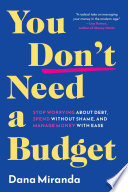

Traditional budgeting often focuses on restrictions and limitations, which can lead to feelings of deprivation and frustration. The author argues that this approach is fundamentally flawed because it does not account for the realities of human behavior and spending patterns. Instead of imposing a rigid budget, individuals should focus on their financial goals and values. By doing so, they can create a more flexible financial plan that allows for personal preferences while still achieving long-term objectives. This shift in mindset encourages individuals to prioritize their spending based on what truly matters to them, rather than adhering to arbitrary categories and limits.
Continue readingOne of the core concepts in the book is value-based spending, which emphasizes spending money on things that align with one's values and priorities. This approach encourages readers to evaluate their expenditures and determine whether they contribute positively to their lives. By focusing on what brings joy and satisfaction, individuals can make more informed choices about their finances. The author provides strategies for identifying personal values and aligning spending habits accordingly. This not only enhances financial well-being but also fosters a greater sense of fulfillment and purpose in life.
Continue readingFinancial awareness is a key theme in the book, as it emphasizes the need for individuals to have a clear understanding of their financial situation. The author advocates for regular tracking of income and expenses, not as a means of restricting spending but as a way to gain insight into financial habits. By becoming aware of spending patterns, individuals can identify areas where they may be overspending or underutilizing resources. This knowledge empowers readers to make proactive decisions about their finances, ultimately leading to improved financial health and stability.
Continue readingFlexibility is a central tenet of the book, as the author argues against the rigidity of traditional budgeting practices. Instead of adhering to strict rules, individuals are encouraged to embrace a more adaptable approach to managing their finances. This means being open to adjusting spending habits as circumstances change and recognizing that financial goals may evolve over time. The author discusses the importance of being responsive to life’s unpredictability and how flexibility can lead to better financial outcomes. This mindset allows for a more dynamic relationship with money, reducing stress and enhancing overall financial well-being.
Continue readingAutomation is presented as a powerful tool for managing finances without the burden of constant monitoring. The author discusses various automated systems for saving, investing, and bill payments that can simplify financial management. By setting up automatic transfers and payments, individuals can ensure that their financial goals are met without the need for ongoing intervention. This approach not only saves time but also reduces the likelihood of missed payments or overspending. The author emphasizes that automation can help create a more effortless financial management experience, allowing individuals to focus on their priorities.
Continue readingThe concept of a financial freedom plan is introduced as an alternative to traditional budgeting. This plan focuses on long-term financial goals and the steps necessary to achieve them. The author encourages readers to define their vision of financial freedom and create actionable steps to reach that vision. This approach is about building a sustainable financial future rather than merely surviving month-to-month. The book provides a framework for developing this plan, which includes setting specific goals, identifying obstacles, and creating a roadmap for achieving financial independence.
Continue readingA significant aspect of the book revolves around the mindset individuals have towards money. The author argues that many people hold negative beliefs about money that can hinder their financial success. By addressing these beliefs and adopting a more positive and empowering perspective, individuals can transform their relationship with money. The book offers strategies for cultivating a healthy mindset, including gratitude practices and reframing negative thoughts. This shift in perspective can lead to better financial decisions and a more positive outlook on life as a whole.
Continue reading